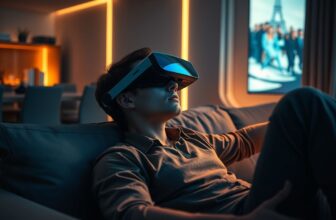AR glasses key features are rapidly evolving, bringing digital information into your real-world view. This guide breaks down everything you need to know about augmented reality glasses – from understanding the technology and its benefits, to finding the best options for first-time users and exploring what you can actually *do* with them.
the target audience.
## AR Glasses Explained: How Does Augmented Reality Work?
To understand **AR glasses key features**, we first need to demystify what augmented reality (AR) actually is. In simple terms, AR overlays computer-generated images onto your view of the real world. Think of it as enhancing your perception of reality, rather than replacing it entirely. This is where it significantly differs from virtual reality (VR). **AR glasses vs VR glasses** lies in the experience: VR creates a completely immersive digital environment, blocking out the world around you, while AR just adds to it. Imagine seeing furniture virtually placed in your lounge room before buying it – that’s AR.
So, how do these devices work? **AR glasses explained** comes down to combining several key components working in harmony. The core has these: displays, sensors, processors, and the connectivity allowing this to function.
### Key Components: What’s Inside?
Let’s break down the **key specs of AR glasses**. first the displays, these project the digital images over your. They come in several forms, including:
* **Waveguide displays:** The most current option, they guide light illuminates so it appears in your field of view. A lot seen in current models like the XReal Air.
* **Holographic displays:** Utilizing diffraction to create an image in 3D. More difficult to perfect and brighter in the environment.
* **Retinal projection:** Projects lasers directly onto your retina. Displays are very sharp but can be costly and raise safety considerations.
Next, **sensors** are critical. These include:
* **Cameras**: Capture the real world, translating that into data about your surroundings.
* **Depth sensors**: Measure the distance of objects, letting the AR software know where to place that digital overlay.
* **IMUs (Inertial Measurement Units)**: Track head movement and orientation, so the digital images stay locked in place as you move.
Then, there is the **processor:** It’s the brain and all computing for the AR system. It handles sensor data and displays that information. Finally, **connectivity** (such as Bluetooth and WiFi) allows interaction with smartphones and or computers.
The four most important components of AR glasses.
### Challenges and Future Developments
Creating seamless AR isn’t without challenges. Achieving a **wide field of view**, so the digital overlays don’t feel restricted, is a major hurdle. **Accurate tracking** is also crucial – any lag or jitter breaks the illusion. Minimizing **latency** (the delay between your movement and the digital response) is critical for a comfortable experience. **AR glasses battery life expectations** also need improvement, a real deterrent.
The history of AR has been a steady climb. Early attempts were clunky and overly expensive but over the last decade, development improved dramatically. These systems are moving towards a future where sleek, comfortable, and affordable AR glasses become part of everyday life. For instance, within **healthcare**, surgeons are employing AR for visualizations during procedures, while **manufacturing** uses it for assembly instructions, or within **retail** to try on clothes virtually.
**Hands-free AR technology** can significantly improve productivity and efficiency, and **AR glasses use cases for everyday life** are becoming numerous. **The future of AR glasses 2025** is expected to bring increased processing power, and expanded applications. If you’re interested in seeing these new experiences firsthand, check out **AR glasses Melbourne stores** and opportunities for an **augmented reality glasses Ormond demo**.
Navigating the world of AR glasses for the first time can feel overwhelming. Understanding the AR glasses key features is crucial to making an informed decision. Several factors contribute to a positive augmented reality experience, and prioritizing these will ensure you choose a device that suits your needs. Let’s break down the essential elements to consider.
Key Specs of AR Glasses: What to Look For
First, consider the display quality. Resolution and brightness significantly impact how clear and immersive the AR experience is. A higher resolution means sharper visuals, while good brightness ensures visibility in various lighting conditions. Next is the field of view (FOV) – this determines how much of your vision is covered by the augmented content. A wider FOV feels more natural and immersive. Weight is also critical; heavier glasses can become uncomfortable during extended use. Battery life is a constant concern (more on that later!), and processing power dictates how smoothly apps run and how complex the AR experiences can be. Finally, the software ecosystem – the availability of apps and developer support – is vital for long-term usability.
Let’s look at an AR glasses features comparison 2025. Models like the XREAL Air 2 Pro are gaining traction for their sleek design and focus on media consumption, while Microsoft HoloLens 3 (expected in late 2025) will likely remain a powerhouse for enterprise applications. The Magic Leap 3, though pricier, aims for a more refined AR experience with improved optics. New entrants from companies like Lenovo and TCL are also expected to shake up the market.
| Feature | XREAL Air 2 Pro (2025) | Microsoft HoloLens 3 (Expected 2025) |
|---|---|---|
| Price (Estimate) | $400 – $600 | $3,500+ |
| Primary Use | Entertainment, Productivity | Enterprise, Industrial |
| Field of View | 40-50 degrees | 50-60 degrees |
| Weight | 65g | 500-600g |
Price Points: Affordable vs. Premium
Affordable AR glasses options, like the XREAL Air 2 Pro, typically focus on entertainment and productivity, offering a good entry point into AR. These often require connection to a smartphone or other device. Premium models, such as the HoloLens 3 and Magic Leap 3, boast more advanced features, greater processing power, and are geared towards professional use. Expect to pay a significant premium for these capabilities.
Compatibility with smartphones and other devices is a key consideration. Many AR glasses function as external displays for your phone, while others have their own operating systems. Ensure the glasses you choose are compatible with your existing tech.
PROS of AR Glasses
- Hands-free information access
- Immersive entertainment experiences
- Enhanced productivity
CONS of AR Glasses
- Battery life limitations
- Potential privacy concerns
- Cost (for premium models)
AR Glasses Battery Life Expectations
AR glasses battery life expectations currently range from 2-4 hours for consumer models, and potentially longer for enterprise solutions with external battery packs. To maximize battery performance, reduce screen brightness, disable unnecessary features, and close unused apps.
Common concerns for first-time users include comfort (try before you buy if possible!), privacy (be mindful of what the cameras can see), and security (ensure the device has robust security features). If you’re in Melbourne, several AR glasses Melbourne stores offer demonstrations. Keep an eye out for an augmented reality glasses Ormond demo to experience the technology firsthand.
Caption: Estimated battery life for popular AR glasses models.
, and also provide the context for the chapter.
___
## Beyond Gaming: Everyday Use Cases & The Future of Hands-Free AR
While the initial hype surrounding AR glasses often centers on gaming and entertainment, the true potential lies far beyond. Exploring **AR glasses key features** isn’t just about graphics rendering, it’s about fundamentally changing how we interact with the world around us. These devices are rapidly evolving into powerful tools with **AR glasses use cases for everyday life** that promise increased productivity, accessibility, and convenience. We’ll delve into how that unfolds, focusing on practical applications and future possibilities.
Navigating Your World with AR
Imagine strolling through a new city, and instead of constantly checking your phone for directions, subtle arrows and points of interest are overlaid directly onto your vision, courtesy of **hands-free AR technology**. Several AR glasses models now offer robust navigation features, powered by integrations with popular mapping applications. This ability extends beyond simple walking directions; construction workers can visualize underground utilities, and first responders can receive critical situational awareness data in real-time. This is a prime example of the **augmented reality glasses benefits** offered by this emerging technology.
Navigation Method Reliance: Illustrating the potential shift from mobile devices to AR glasses for everyday navigation.
Enhancing Daily Tasks and Communication
The possibilities expand beyond navigation. **What can you do with AR glasses?** Quite a lot! Consider hands-free cooking where recipes are projected onto your countertop, guiding you through each step. Remote assistance becomes significantly more effective, with technicians able to see through the eyes of a field worker, providing real-time guidance and troubleshooting support. Imagine the benefits for elderly relatives, with family members remotely assisting them with tasks they find challenging. Real-time translation is another powerful application. Communicating with someone who speaks a different language becomes effortless with translated subtitles appearing directly in your field of view. This contrasts sharply with **AR glasses vs VR glasses** where the latter prioritizes full immersion, whereas AR aims to enhance our existing reality.
Workplace Efficiency and Safety
In industrial settings, **hands-free AR technology** is already transforming workflows. Technicians can access schematics and repair manuals without needing to stop and consult a tablet or laptop. Warehouse workers can use AR to identify the correct items for picking and packing, significantly improving efficiency and accuracy. Crucially, AR can also enhance safety. Displaying hazard warnings or safety protocols directly in a worker’s field of view minimizes distractions and reduces the risk of accidents.
The Future of AR Glasses: 2025 and Beyond
Looking ahead to **future of AR glasses 2025** and beyond, several key advancements are expected. Display technology will continue to improve, with higher resolutions, wider fields of view, and more realistic image fidelity. Processing power will increase, allowing for more complex AR applications and seamless integration with artificial intelligence. Software capabilities, including object recognition and spatial mapping, will become more sophisticated. A major area of development will centre on addressing **AR glasses battery life expectations** – current models often struggle to deliver all-day performance. We’ll also start to see more **affordable AR glasses options** come to market, and more readily available **AR glasses Melbourne stores** offering demonstrations. A potential **augmented reality glasses Ormond demo** could be a great way to experience the tech directly. The **key specs of AR glasses** that consumers evaluate will also likely shift as the technology matures.
“The convergence of 5G, edge computing, and advancements in miniaturized sensors will unlock the true power of AR glasses, ushering in a new era of contextual computing.” – Dr. Anya Sharma, Lead Researcher, FutureTech Institute.
Ethical Considerations and Challenges
Despite the exciting possibilities, widespread adoption of AR glasses also raises ethical concerns. Privacy is paramount – the ability to record and analyze the world around us raises questions about data security and potential misuse. Social implications, such as the potential for increased social isolation or the exacerbation of existing inequalities, also need to be addressed. It’s critical that as the technology advances, that these issues are addressed proactively to ensure equitable and responsible access.Understanding AR glasses key features is the first step to embracing this exciting technology. From everyday use cases to hands-free convenience, augmented reality is poised to transform how we interact with the world. Explore the possibilities and stay informed about the future of AR glasses in 2025 – the future is looking bright!





